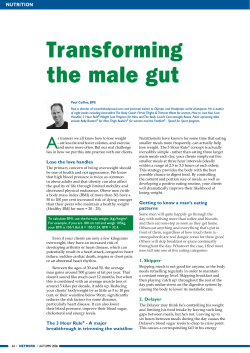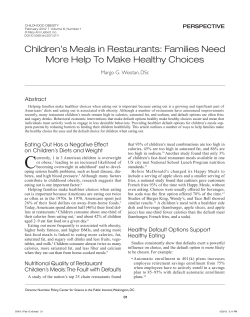
INSTITUTE OF MEDICINE School Meals: Building Blocks for Healthy Children
MEDICINE INSTITUTE OF REPORT BRIEF • OCTOBER 2009 School Meals: Building Blocks for Healthy Children Two national programs—the National School Lunch Program (NSLP) and the School Breakfast Program (SBP)—play key roles in supporting the nutrition and health of schoolchildren in the United States by providing nutritionally balanced, low-cost or free lunches each school day. In 2008, the NSLP provided lunch to more than 30.5 million children, and the SBP provided breakfast to 10.5 million children. Currently, to receive federal reimbursement, school meals must meet regulations that were established in 1995 for Nutrition Standards and Meal Requirements. The complex set of regulations specifies amounts of nutrients that must be provided, meal planning approaches, and rules for the food that must be on the student’s tray. Advances have been made in dietary guidance in the years since those regulations were established. To obtain assistance in updating the regulations, the U.S. Department of Agriculture (USDA) asked the Institute of Medicine (IOM) to provide recommendations to revise the standards and requirements for both the NSLP and the SBP. To meet its task, an IOM committee reviewed and assessed the food and nutritional needs of school-aged children in the United States using the 2005 Dietary Guidelines for Americans set by the Department of Health and Human Services (HHS) and USDA, as well as the IOM’s Dietary Reference Intakes (DRI). Furthermore, the committee reviewed the current regulations for the NSLP and SBP Nutrition Standards and Meal Requirements. The committee recommends numerous revisions and that emphasis be placed on revised Meal Requirements rather than on nutrients per se. The committee’s recommended new approach clearly focuses on providing meals that are consistent with the Dietary Guidelines for Americans. The committee’s recommended new approach clearly focuses on providing meals that are consistent with the Dietary Guidelines for Americans. RECOMMENDED MEAL REQUIREMENTS The committee makes recommendations for Meal Requirements, which encompass two types of standards: 1) standards for menu planning and 2) standards for meals as selected by the student (in contrast to those that are simply offered to students). Standards are needed for meals as selected because, by law, all high schools are required to allow students to decline a specified number of food items (to reduce waste), and other schools may choose to do so (a majority of them do so). In order to align school meals with the Dietary Guidelines for Americans and improve the healthfulness of school meals, the committee recommends that the Food and Nutrition Service of the USDA adopt standards for menu planning that: • increase the amount and variety of fruits, vegetables, and whole grains; • set a minimum and maximum level of calories; and • increase the focus on reducing the amounts of saturated fat and sodium pro- vided. For more information visit www.iom.edu/schoolmeals. Advising the Nation. Improving Health. The committee recommends a single approach to menu planning—one that includes a meal pattern (which specifies the types and amounts of food in the meal) plus specifications for minimum and maximum calorie levels, maximum saturated fat content, and maximum sodium content. Some of the recommended changes are described in Table 1. Because the meal pattern alone cannot ensure appropriate amounts of calories, saturated fat, and sodium, the committee set specifications for those three dietary components. The combination results in meals that are nutrient-rich but moderate in calories. The committee recommends a single approach to menu planning— table 1: KEY Recommended Changes in School lunch requirements a meal pattern Type of Specification plus specifications Fruits one that includes for minimum and maximum calorie levels, Vegetables maximum saturated fat content, and maximum sodium content. Current Requirements Considered together as a fruit and vegetable group. No specifications for the type of vegetable Recommendations Required daily amount increased Two servings required daily, amount increased. Must include dark green, bright orange, legumes, starchy, and other vegetables each week Grains/ Breads No requirement for whole grains At least half must be whole grain rich Milk Whole, reduced-fat, lowfat, fat-free milks (plain or flavored) Fat-free (plain or flavored) and plain low-fat milk only Calories Must meet minimum level Must be within minimum and maximum level Sodium None (decreased level recommended) Gradually but markedly decrease sodium to the specified level by 2020 The committee developed two options for the standards for meals as selected by the student. The options differ in the number of food items that may be declined, but both of the options include a new specification: that the student must select a fruit at breakfast and either a fruit or a vegetable at lunch for the meal to be reimbursable. NUTRIENT TARGETS The current Nutrition Standards include eight specific requirements covering calories, fat, protein, and several vitamins and minerals. To achieve consistency with Dietary Guidelines and the DRIs, however, the committee found it necessary to increase the number of nutrients considered and, using a new concept, to replace Nutrition Standards with Nutrient Targets. The committee developed the Nutrient Targets (which encompass 24 nutrients and other dietary components) as guidelines to determine the amount and type of food groups to be offered to students. These are not intended to be used as specific requirements for menu planning or to monitor menus, as is the case with the current Nutrition Standards. 2 The committee stresses the importance of reducing the sodium content of foods and, therefore, recommends that USDA work cooperatively with HHS, the food industry, professional organizations, state agencies, advocacy groups, and parents to develop strategies and incentives to achieve such a task. The committee recognizes that there are barriers to reducing the sodium content of meals to the levels that are recommended without having adverse effects on student acceptance and participation, safety, practicality, and cost. In recognition of the barriers, the committee suggests that implementation be fully achieved by 2020; and it proposes that intermediate targets be set at two-year intervals and periodically evaluated to promote step-wise reductions in sodium content over the decade beginning in 2010. RECOMMENDATIONS FOR IMPLEMENTATION AND MONITORING The manner in which Meal Requirements are implemented and monitored will determine whether students participate in the NSLP and SBP and consume the food that is offered. Important implementation strategies to promote change and increase student participation in the program include engaging the school community; involving students, parents, and the community; providing nutrition education; training and mentoring food service workers; and providing technical assistance. Industry involvement will be essential to the implementation process, including the introduction of appealing foods that are lower in sodium and saturated fat and those that have a higher ratio of whole grain to refined grain. In addition, new monitoring procedures will guide implementation efforts. Recommended support from the Food and Nutrition Service includes: • Technical assistance for developing and continuously improving menus, ordering appropriate foods (including the writing of specifications), and controlling costs while maintaining quality. • New procedures for monitoring the quality of school meals that (1) focus on meeting relevant Dietary Guidelines, and (2) provide information for continuous quality improvement and for mentoring food service workers to assist in performance improvement. With comprehensive technical assistance from USDA and the support and involvement of state agencies, professional organizations, the food industry, child advocacy groups, schools, parents, and students, these school meals will appeal to students and contribute to their health and well being. CONCLUSION Since the NSLP’s inception, more than 219 billion lunches have been served. Implementation of the committee’s recommendations will lead to healthier meals in the NSLP and the SBP—meals that are much more consistent with Dietary Guidelines for Americans. With comprehensive technical assistance from USDA and the support and involvement of state agencies, professional organizations, the food industry, child advocacy groups, schools, parents, and students, these school meals will appeal to students and contribute to their health and well being. 3 FOR MORE INFORMATION . . . Copies of School Meals: Building Blocks for Healthy Children are available from the National Academies Press, 500 Fifth Street, N.W., Lockbox 285, Washington, DC 20055; (800) 624-6242 or (202) 334-3313 (in the Washington metropolitan area); Internet, www.nap.edu. The full text of this report is available at www. nap.edu. This study was supported by funds from the Department of Agriculture. Any opinions, findings, conclusions, or recommendations expressed in this publication are those of the author(s) and do not necessarily reflect the views of the organizations or agencies that provided support for this project. The Institute of Medicine serves as adviser to the nation to improve health. Established in 1970 under the charter of the National Academy of Sciences, the Institute of Medicine provides independent, objective, evidence-based advice to policymakers, health professionals, the private sector, and the public. For more information about the Institute of Medicine, visit the IOM web site at www.iom.edu. Permission is granted to reproduce this document in its entirety, with no additions or alterations. Copyright © 2009 by the National Academy of Sciences. All rights reserved. Committee on NUTRITION STANDARDS FOR NATIONAL SCHOOL LUNCH AND BREAKFAST PROGRAMS VIRGINIA A. STALLINGS, (Chair), The Children’s Hospital of Philadelphia, University of Pennsylvania; KAREN WEBER CULLEN, Children’s Nutrition Research Center, Baylor College of Medicine, Houston,TX; ROSEMARY DEDERICHS, Minneapolis Public Schools, Special School District No. 1, MN; MARY KAY FOX, Mathematica Policy Research, Inc., Cambridge, MA; LISA HARNACK, Division of Epidemiology and Community Health, University of Minnesota, MN; GAIL HARRISON, School of Public Health, Center for Health Policy Research, University of California, Los Angeles; MARY ARLINDA HILL, Jackson Public Schools, MS; HELEN H. JENSEN, Department of Economics, Iowa State University, Ames; RONALD E. KLEINMAN, Massachusetts General Hospital for Children, Harvard Medical School, Boston, MA; GEORGE P. McCABE, College of Science, Purdue University, West Lafayette, IN; SUZANNE P. MURPHY, Cancer Research Center of Hawaii, University of Hawaii, Honolulu; ANGELA ODOMSYOUNG, Department of Kinesiology and Nutrition, University of Illinois at Chicago, IL; YEONHWA PARK, Department of Food Science, University of Massachusetts, Amherst; MARY JO TUCKWELL, inTEAM Associates, Ashland, WI Study Staff CHRISTINE TAYLOR, Study Director; SHEILA MOATS, Associate Program Officer; JULIA HOGLUND, Research Associate; HEATHER BREINER, Program Associate; CAROL WEST SUITOR, Consultant Subject Matter Expert and Writer; ANTON BANDY, Financial Officer; GERALDINE KENNEDO, Administrative Assistant, Food and Nutrition Board; LINDA D. MEYERS, Director, Food and Nutrition Board 4
© Copyright 2025





















